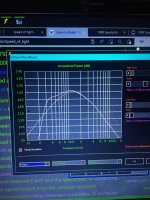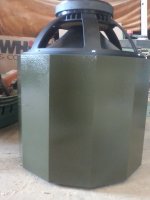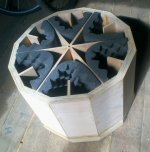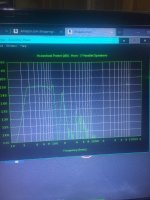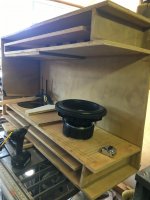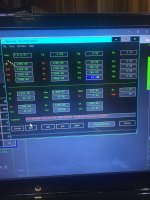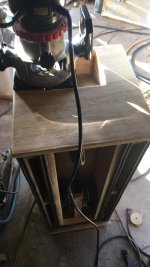Any good ideas? No restrictions on size, no requirements, anything you got ill consider? Appreciated in advance.
thx!
thx!
In this case, I would check B&C's website for their suggested designs!
https://www.bcspeakers.com/resources/suggested-designs/
https://www.bcspeakers.com/resources/suggested-designs/
Whats ‘lots of power? Thankfully starting as a 3.3 ohm dcRe!Sealed, Q=0.5, lots of power and EQ, no question.
I'm more in the PA field, but use 2kW on 700w 18" drivers. Nothing in 40+ years has indicated to me that there is such a thing as 'Too much power'!Whats ‘lots of power? Thankfully starting as a 3.3 ohm dcRe!
Response looks very similar to my B&C 18PZB100 in 55l, as it would! Driver externally mounted to reduce power compression, and I only use a low frequency HPF if the system is being used for vinyl. It will sound very, very good indeed, and is dead simple and cheap to build. Super inefficient, but what price perfection? 😉Sealed in 2ft3? With an EQ and a BW filter at 30hz?
Attachments
A huge - to my ears - fidelity advantage often overlooked is the extremely short settling time of sealed enclosures, since there is minimal energy storage, especially if the enclosure is suitably rigid. (I never use or require any panel damping in my sealed subs). Larger ported and horn-loaded enclosures store considerable energy which is only slowly dissipated and can still be ringing 250ms after the signal has ceased, where sealed enclosures are typically limited to 20ms or less. To me this makes a huge difference with complex or very fast drum beats used by bands such as Metallica. This rapid double pedal kick drum is a very good test and always sounds very woolly and blurred to me on all but sealed subs. Why not build one and see what you think - it's quick, cheap and simple, but perhaps not quite so with my particular design!
Attachments
A huge - to my ears - fidelity advantage often overlooked is the extremely short settling time of sealed enclosures, since there is minimal energy storage, especially if the enclosure is suitably rigid. (I never use or require any panel damping in my sealed subs). Larger ported and horn-loaded enclosures store considerable energy which is only slowly dissipated and can still be ringing 250ms after the signal has ceased, where sealed enclosures are typically limited to 20ms or less. To me this makes a huge difference with complex or very fast drum beats used by bands such as Metallica. This rapid double pedal kick drum is a very good test and always sounds very woolly and blurred to me on all but sealed subs. Why not build one and see what you think - it's quick, cheap and simple, but perhaps not quite so with my particular design!
When you go to a Metallica concert, are they using sealed subwoofers? No, they most certainly are not. You are welcome to your thoughts, and I encourage people to build and experience different enclosures to evaluate for themselves.
Perhaps you suffer from in-room resonances with long decay times that lead you to believe that ported or other enclosures sound wooly or blurred.
The long decay times of sealed and horn loaded LF enclosures are not my thoughts or my beliefs, they are reality unless you have data which shows otherwise. I do not go to large scale venues any more because of the unfailingly lamentable sound quality.
If a flat response curve is more important then the enclosure having a small fraction of the GD of the listening space, and you are prepared to sacrifice dynamics and punch, then a large closed box is probably a great way to go. I prefer the physical sensation of "effortless and dynamically uncompromised" reproduction where the bass is just present in the room in a very "live music" kind of way. I am prepared to sacrifice some tonal smoothness (if that is even a thing in a highly reverberate listing space like a car cabin or a living room) and I am prepared to add 30 - 50 ms GD on top of the typical 500 ms GD from the listing environment to get the other qualities.
I love high order QW designs, and I am quite proud of my and Anders Martinssons ROAR series. I do understand that they do not suit everyone, but the effortless and high resolution reproduction of highly dynamic and non-linear low frequency content of music and HT LF tracs is worth the trade-of mentioned above.
I love high order QW designs, and I am quite proud of my and Anders Martinssons ROAR series. I do understand that they do not suit everyone, but the effortless and high resolution reproduction of highly dynamic and non-linear low frequency content of music and HT LF tracs is worth the trade-of mentioned above.
Indeed. 2 of these are in my SUV.If a flat response curve is more important then the enclosure having a small fraction of the GD of the listening space, and you are prepared to sacrifice dynamics and punch, then a large closed box is probably a great way to go. I prefer the physical sensation of "effortless and dynamically uncompromised" reproduction where the bass is just present in the room in a very "live music" kind of way. I am prepared to sacrifice some tonal smoothness (if that is even a thing in a highly reverberate listing space like a car cabin or a living room) and I am prepared to add 30 - 50 ms GD on top of the typical 500 ms GD from the listing environment to get the other qualities.
I love high order QW designs, and I am quite proud of my and Anders Martinssons ROAR series. I do understand that they do not suit everyone, but the effortless and high resolution reproduction of highly dynamic and non-linear low frequency content of music and HT LF tracs is worth the trade-of mentioned above.
Attachments
With those specs i would say a folded horn is the best suited. But a sealed wit a lot of eq can also work on relative lower power (xmax is the limiting factor here).
Reflex won't work well, just like TL type won't. Bandpass i don't know, i'm not very knowledgable of this type of alignments, i don't like those so no interest in learning them.
Reflex won't work well, just like TL type won't. Bandpass i don't know, i'm not very knowledgable of this type of alignments, i don't like those so no interest in learning them.
Try this? I play with miniature versions initially(4” drivers) because of apprehensions in the higher order stuffWith those specs i would say a folded horn is the best suited. But a sealed wit a lot of eq can also work on relative lower power (xmax is the limiting factor here).
Reflex won't work well, just like TL type won't. Bandpass i don't know, i'm not very knowledgable of this type of alignments, i don't like those so no interest in learning them.
Attachments
The cone control is rediculous. Its never going to be mechanical fail, gonna have to be thermal at high outputs and neglect of that it seems.Try this? I play with miniature versions initially(4” drivers) because of apprehensions in the higher order stuff
so distortion per output is super low and group delay is 26-30m/sec at ~Fb spike alone. these enclosures seem to have a window of opportunity and then a whole bunch of other methods to built them that tend to suck if not appropriately designed.
And then what about impulse?
People want to argue that all the time as well in these. Safe to assume due to a lot of bad apples amongst oranges Theres subsequently astigmatism or the same thing there always is…
The majority is always wrong. when individuals discover loopholes or little areas of oasis amongst the desert😂🤷🏻
I dunno, not really seeing this measured much? And what it is it’s obviously a bad example to support someone’s argument to do something else instead.
- Home
- Loudspeakers
- Subwoofers
- B&C 18 DS115 ideal enclosure (not for PA use)?
